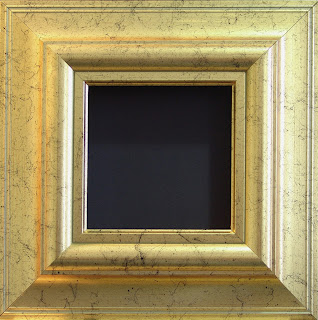Refinish those old frames!!
"Cheap" looking metal leaf frame
refinished warm antique black with soft handrubbed patina
As artists we all seem to accumulate those frames that we just don't know what to do with. They may have gotten damaged shipping to a gallery or banged around transporting to a show. Maybe they were "ok" frames but the finish just wasn't up to gallery standards or the color just won't work with the art.
There are many ways to bring new life back to those old frames so they can come out of the closet and hang proudly on your best art!
I have been a fine art restorer for over 35 years and have learned many tricks about refurbishing damaged frames that I would like to share. Most artists have the ability to refurbish their own frames but they lack the know-how. Being able to modify your own frames can not only save $1000's of dollars, but it can even open a whole new opportunity to the artist to individualize and modify their frames to be one of a kind pieces that will enhance their art.
I am going to give a step-by-step for you on creating this lovely soft, handrubbed black finish, however, these same steps can be used to modify an existing finish or work with other base colors than just black.....have fun, get creative!
A friend and wonderful artist, Connie Kuhnle, has used some beautiful soft, greyed colors for her charming plein air landscapes. One of my favorites is her antiqued mustard/yellow on a white and yellow farmhouse...it is perfect!!
I often use antiquing and waxing to add some interest to a newly purchased frame that just doesn't quite have the richness I am looking for. It is a fairly quick and simple step that can make a remarkable difference.
Frame Makeover
Supply list for warm black antique finish:
2. Red paint- (optional)....same as the black. Used to create a red undertone.
3. Fine steel wool
4. Fine 280 grit sandpaper
5. Antiquing stain.....raw umber oil paint will work, as will acrylic. you can also purchase a stain like Minwax in a dark walnut color.
6. Rottenstone
7. Wax/polish for wood ( I like “Bison” Black ebony best)
9. Polyurethane wood finish, semigloss, brush or spray
If an antique white frame is desired you will need white paint in place of the black. This same finish works beautifully with a color as well.
- Lightly sand original finish to cut the gloss a bit and allow for better adhesion of the new paint.
- Pound the frame casually, bouncing the clawside of the hammer over the surface to create even (but not too uniform) scars and indentations if you want a more antique look.
- Spray (or brush on) with red paint (if red undertone is desired). (allow to dry as per instructions on the paint).
- Lightly steel wool
- Spray (or brush on) black enamel. (allow to dry)
- Use sandpaper on edges and across the surface to allow some red to show through and give a “worn” look to the finish. It is going to look best if you have fairly even streaking throughout the frame. If the streaking is not even the frame will look splotchy.
- Apply raw umber antiquing with a wide brush and wipe with a soft rag, paper towel, or cheesecloth to remove some but not all of the antiquing. Allow stain to remain in the crevices as well as the indentations that you made. Allow to dry.
- Spray or brush with polyurethane finish to seal. Allow to dry.
- Apply polishing wax and allow it to dry then buff to a nice handrubbed lustre.
- Dust lightly with rottenstone...especially in crevices and detailing of frame. Buff again.
While the steps may seem time consuming they really are not. It is important to give each of the finish layers time to dry so start to finish will take a couple of days but actual time working on the frame shouldn’t be more than an hour or two. With practice you will find it easier and easier to achieve the results you are after and start adding your own variations to create one of a kind finishes!


what is rottenstone?
ReplyDeleteRottenstone is a polishing buffing compound (purchased at any wood working store) It is crushed stone. It also is used in antiquing frames to create a soft "dusty" look.
DeleteGreat idea, Barbara! I have lots of frames with various dings, scratches or lifted off gold leaf that could be fixed with this approach. Thanks for sharing! Oh, and do you have a source you can recommend for the Black Bison Ebony paste wax you use? I don't seem to be able to find it online.
ReplyDelete